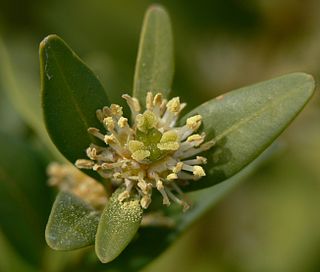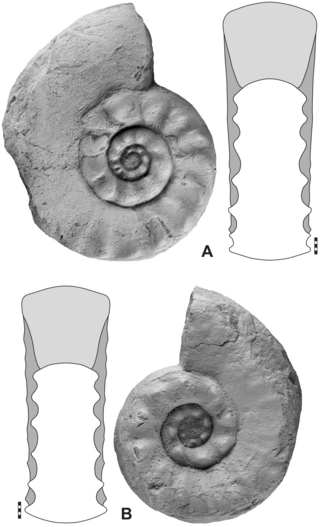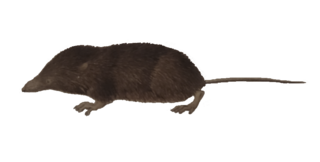
Genus is a taxonomic rank above species and below family as used in the biological classification of living and fossil organisms as well as viruses. In binomial nomenclature, the genus name forms the first part of the binomial species name for each species within the genus.

Vespertilionidae is a family of microbats, of the order Chiroptera, flying, insect-eating mammals variously described as the common, vesper, or simple nosed bats. The vespertilionid family is the most diverse and widely distributed of bat families, specialised in many forms to occupy a range of habitats and ecological circumstances, and it is frequently observed or the subject of research. The facial features of the species are often simple, as they mainly rely on vocally emitted echolocation. The tails of the species are enclosed by the lower flight membranes between the legs. Over 300 species are distributed all over the world, on every continent except Antarctica. It owes its name to the genus Vespertilio, which takes its name from a word for bat, vespertilio, derived from the Latin term vesper meaning 'evening'; they are termed "evening bats" and were once referred to as "evening birds".

The International Code of Zoological Nomenclature (ICZN) is a widely accepted convention in zoology that rules the formal scientific naming of organisms treated as animals. It is also informally known as the ICZN Code, for its publisher, the International Commission on Zoological Nomenclature. The rules principally regulate:

In biology, a subgenus is a taxonomic rank directly below genus.

Laridae is a family of seabirds in the order Charadriiformes that includes the gulls, terns, noddies, skimmers, and kittiwakes. It includes around 100 species arranged into 22 genera. They are an adaptable group of mostly aerial birds found worldwide.

Herons are long-legged, long-necked, freshwater and coastal birds in the family Ardeidae, with 74 recognised species, some of which are referred to as egrets or bitterns rather than herons. Members of the genus Botaurus are referred to as bitterns, and, together with the zigzag heron, or zigzag bittern, in the monotypic genus Zebrilus, form a monophyletic group within the Ardeidae. Egrets do not form a biologically distinct group from herons, and tend to be named differently because they are mainly white or have decorative plumes in breeding plumage. Herons, by evolutionary adaptation, have long beaks.

The Buxaceae are a small family of six genera and about 123 known species of flowering plants. They are shrubs and small trees, with a cosmopolitan distribution. A seventh genus, sometimes accepted in the past (Notobuxus), has been shown by genetic studies to be included within Buxus.

In biological taxonomy, the type genus is the genus which defines a biological family and the root of the family name.

Lontra is a genus of otters from the Americas.

In the geologic time scale, the Changhsingian or Changxingian is the latest age or uppermost stage of the Permian. It is also the upper or latest of two subdivisions of the Lopingian Epoch or Series. The Changhsingian lasted from 254.14 to 251.9 Ma ago. It is preceded by the Wuchiapingian age/stage and is followed by the Induan age/stage.
In botanical nomenclature, author citation is the way of citing the person or group of people who validly published a botanical name, i.e. who first published the name while fulfilling the formal requirements as specified by the International Code of Nomenclature for algae, fungi, and plants (ICN). In cases where a species is no longer in its original generic placement, both the authority for the original genus placement and that for the new combination are given.

Goupia is a neotropical genus of flowering plants and the sole genus included in the family Goupiaceae. There are three species, all found in tropical northern South America.

Bucerotiformes is an order of birds that contains the hornbills, ground hornbills, hoopoes and wood hoopoes. These birds were previously classified as members of Coraciiformes. The clade is distributed in Africa, Asia, Europe and Melanesia.

Lamiinae, commonly called flat-faced longhorns, are a subfamily of the longhorn beetle family (Cerambycidae). The subfamily includes over 750 genera, rivaled in diversity within the family only by the subfamily Cerambycinae.

Pangasius is a genus of medium-large to very large shark catfishes native to fresh water in South and Southeast Asia. The term "pangasius" is sometimes used to specifically refer to the commercially important basa fish, P. bocourti.

Paratirolites is a genus of latest Permian and earliest Triassic ceratites from Armenia, Azerbaijan, Afghanistan, China and Iran with distinct ribs, prominent ventro-lateral tubercles, and a broadly arched venter. The suture is ceratitic with a large ventral saddle. Ceratites are ammonoid cephalopods that lived during the Late Permian and Triassic.

The Interim Register of Marine and Nonmarine Genera (IRMNG) is a taxonomic database which attempts to cover published genus names for all domains of life, from 1758 in zoology up to the present, arranged in a single, internally consistent taxonomic hierarchy, for the benefit of Biodiversity Informatics initiatives plus general users of biodiversity (taxonomic) information. In addition to containing just over 500,000 published genus name instances as at May 2023, the database holds over 1.7 million species names, although this component of the data is not maintained in as current or complete state as the genus-level holdings. IRMNG can be queried online for access to the latest version of the dataset and is also made available as periodic snapshots or data dumps for import/upload into other systems as desired. The database was commenced in 2006 at the then CSIRO Division of Marine and Atmospheric Research in Australia and, since 2016, has been hosted at the Flanders Marine Institute (VLIZ) in Belgium.

Soriculus is a genus of shrew native to Asia. Along with several fossil species, the only extant member of the genus is the Himalayan shrew, as other extant species have now been transferred to other genera.
Campocraspedon is a genus of ichneumonid wasp in the insect order Hymenoptera. It comprises six species.
















